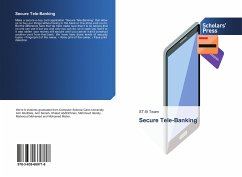
Advanced Immersive Tele-Collaboration
Supporting Closely Coupled Collaboration around Shared Objects in Immersive Virtual Environments
Versandkostenfrei!
Versandfertig in 6-10 Tagen
52,99 €
inkl. MwSt.

PAYBACK Punkte
26 °P sammeln!
Tele-collaboration technologies, such as video-conferencing and shared desktop systems, are used to enable a group of remote people to work together across a distance. We argue that, as of today, linking immersive virtual reality systems provides the closest resemblance of co-location, as remote people and shared objects are brought together in a shared social and spatial context. Balancing responsiveness with consistency, a key factor when employing tele-collaboration systems, however, becomes a great challenge due to the increased data load caused by continuous motion tracking in immersive s...
Tele-collaboration technologies, such as video-
conferencing and shared desktop systems, are used to
enable a group of remote people to work together
across a distance. We argue that, as of today,
linking immersive virtual reality systems provides
the closest resemblance of co-location, as remote
people and shared objects are brought together in a
shared social and spatial context. Balancing
responsiveness with consistency, a key factor when
employing tele-collaboration systems, however,
becomes a great challenge due to the increased data
load caused by continuous motion tracking in
immersive systems. This book identifies issues in
current systems by analysing the development of a
highly collaborative benchmark application using a
representative mature and well-known collaborative
virtual environment system and presents solutions for
future advanced immersive tele-collaboration systems.
This book is for software developers as well as for
researchers and students interested in the technical
issues of modern communication systems.
conferencing and shared desktop systems, are used to
enable a group of remote people to work together
across a distance. We argue that, as of today,
linking immersive virtual reality systems provides
the closest resemblance of co-location, as remote
people and shared objects are brought together in a
shared social and spatial context. Balancing
responsiveness with consistency, a key factor when
employing tele-collaboration systems, however,
becomes a great challenge due to the increased data
load caused by continuous motion tracking in
immersive systems. This book identifies issues in
current systems by analysing the development of a
highly collaborative benchmark application using a
representative mature and well-known collaborative
virtual environment system and presents solutions for
future advanced immersive tele-collaboration systems.
This book is for software developers as well as for
researchers and students interested in the technical
issues of modern communication systems.












